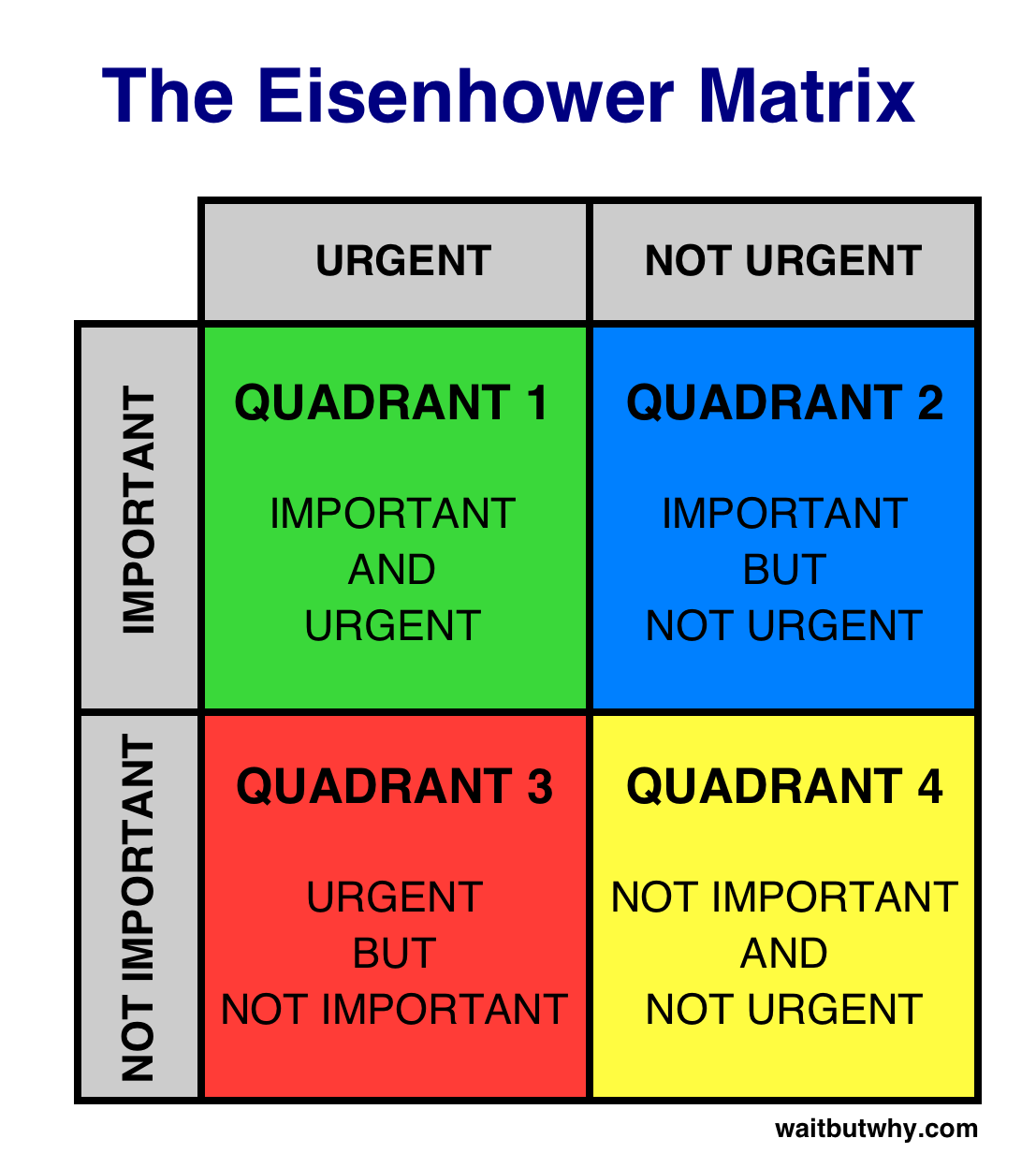If you're into "productivity" (or Amplenote), you've probably seen this graph once or twice before:

The allure of the graph is both intuitive and well-documented. If you just cross out your tasks from Q4, it would be the One Weird Trick that finally unlocks your unbounded productive potential!@#! Tim Urban, of WaitButWhy fame, and one of my favorite authors, makes the implication of this graph explicit in his oldie-but-goodie (dare I say "classic"?) post on this subject:

I am here to argue that if your recipe for task choosing is this reductionistic, you will fare worse than if you didn't have a strategy in the first place.
linkThe curious case of Q4
Before I spend the remainder of this article arguing against the classic interpretation of the Eisenhower Matrix, I should hasten to acknowledge that, to Amplenote, this modest-looking graph is the guiding oracle. This little graph was a big piece of what inspired us to start building our app in the first place. So, props to the suggestions to "do" Q1, "avoid/delegate" Q3, and "schedule" Q2.
It is only the suggestion to "delete Q4 items" that should be deleted.
Q4 items are often the "broadest" or "most random" flavor of items on a to-do list. They are high variance in how great a long-term ROI will be accrued by their completion. On average, the benefit to finishing Q4 tasks is low. That's why conventional wisdom simplifies Q4 as "no ROI," on average, yes, it can be dismissed.
But I will cite examples below to prove that "Q4 tasks" can yield opportunities that your competitors will miss.
link"Dismissing" as religion
If Amplenote's "Tao of Todo Lists" had to be condensed to a single line, it would be "Dismiss more."
The average digital todo list user is in a perpetual cycle of exasperation at how annoying their todo lists have become. They often interpret this frustration as "needing to learn some new acronyms" aka "learning a new PKIM strategy." The truth is that they probably don't need a system, because circumstances change too often, too unpredictably to make back the large time/brainspace investment that goes into learning some else's ideas about how to arrange your knowledge & tasks.
The average overall todo list user avoids the perpetual frustration of their digital counterpart by automatically dismissing tasks every day. When your list is handwritten anew each day, the incentive and opportunity to dismiss is right where it should be. To the extent that Daily Note functionality has become popular among note/task apps, it is a variation on the flavor of auto-dismiss that handwritten note takers enjoy.
linkWhat's "Important"?
The definition of "Urgent" is pretty unambiguous (a task that needs to get done today, or at least in the next few days), but "Important" can be interpreted variously. I recommend applying it to any task that corresponds with what you deem as long-term goals.
For example, Amplenote's budding plugin implementation recently began to allow embedded HTML and Javascript. This makes plugins a big, long-term target for us to invest in. Thus, ideas like the Plugin Bounty Board get marked "Important" and get to bypass the full queue.
linkExamples of Q4 success
There are at least two cases where deleting Q4 tasks is wrong.
The more boring case is when people use their todo lists for banal tasks, like groceries, book recommendations, or products to consider buying. "Purchase" and "investigate" tasks are rarely Important or Urgent. But people tend to want to do this flavor of Q4 task. You don't need to be convinced to not delete these tasks, but it is pedantically accurate to cite "household tasks" as a sort of Q4 that is worth doing...eventually.
The more interesting case is when Q4 tasks are high variance. To my mind, a canonical "high variance" Q4 task is "custom emojis" in Slack.
Any user of Slack (or Discord) user can attest that uploading images to act as custom emojis for a company creates a dialect that becomes "culture." The culture of our company happens to revolves around this set of characters:

At this point, I can't imagine using a chat app that didn't allow custom emojis. But was this considered an "Important" task to Slack? Highly unlikely, based on the absence of the feature (custom emojis unavailable) within Microsoft Teams.
Most likely, "Custom Emojis" happened to sneak into production in the early/fast-moving phase of Slack. Was it going to drive revenue? No. At least, not measurably. Features like this originate when either 1) the team itself wants the feature or 2) the team has a culture of carving off time to progress on Q4 tasks. Ideally, both.
linkQ4 is whimsy
What else wouldn't exist without time spent on Q4 tasks? The entire cast of characters that celebrate you completing a task.
These certainly weren't Important. To a Q4 traditionalist ("Q4 = Delete It"), these tasks should never have existed. Each of the task animations took 10+ hours to complete.
As with Slack's custom emojis, the only reason that Amplenote has whimsical "task complete" animations is that we recognize and respect the role that non-urgent, non-important tasks have for the long-term wellbeing of oneself or one's product.
linkBottom line
Most of the time, you should be working on Q1 and Q2 tasks. But, smart/motivated people can find extravagant tasks in the Q4 section of their roadmap. Slack has proved the value that accrues to companies that pursue excellence beyond directly measurable profitability.
A healthy todo list probably dismisses around 50% of Q4 tasks. But, in Slack's case, that other 50% is what defined the company's value, and helped keep it relevant after Microsoft broke into the "team chat" space. If you dismiss too many Q4 tasks, you'll be missing some great opportunities to differentiate. Being able to keep (and dismiss, and snooze) Q4 tasks is another benefit afforded by Task Score.

Comments
Login to leave a comment